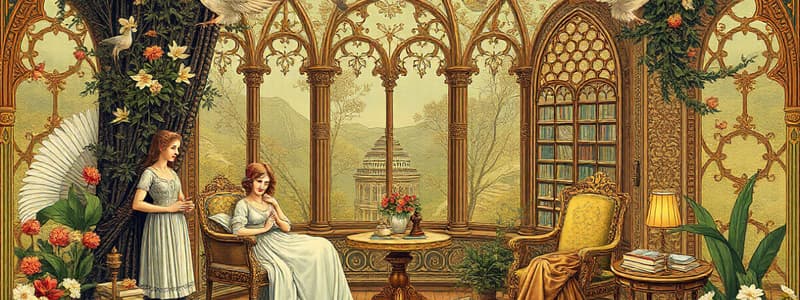Podcast
Questions and Answers
Why did magazines come to occupy the middle ground between books and newspapers?
Why did magazines come to occupy the middle ground between books and newspapers?
- Magazines had better paper quality and printing than newspapers, but were published less frequently than books.
- Magazines offered more timely news than books but provided more in-depth coverage than newspapers. (correct)
- Magazines were primarily targeted towards women, a demographic underserved by both books and newspapers.
- Magazines were cheaper to produce than books and had a wider circulation than newspapers.
Early magazines intentionally avoided targeting women as a primary demographic.
Early magazines intentionally avoided targeting women as a primary demographic.
False (B)
What was the first truly successful U.S. mass magazine?
What was the first truly successful U.S. mass magazine?
Saturday Evening Post
The rise of nationwide magazine circulation significantly impacted American ______, fostering a sense of shared identity and culture.
The rise of nationwide magazine circulation significantly impacted American ______, fostering a sense of shared identity and culture.
Match the magazine specialization with its description:
Match the magazine specialization with its description:
How do advertisers benefit from magazine specialization?
How do advertisers benefit from magazine specialization?
Which factor has NOT contributed to the survival of some magazines in the 2020s?
Which factor has NOT contributed to the survival of some magazines in the 2020s?
The role of advertising in the magazine industry has remained constant, with print ads being the primary revenue source.
The role of advertising in the magazine industry has remained constant, with print ads being the primary revenue source.
Explain why many commentators speculated that “Print is dead”.
Explain why many commentators speculated that “Print is dead”.
Flashcards
Magazines' unique position?
Magazines' unique position?
Magazines bridged the gap between books' depth and newspapers' immediacy, offering a blend of timely news and in-depth analysis.
Early magazine evolution?
Early magazine evolution?
Early magazines evolved by reprinting articles from British publications before developing original content.
Early magazines target audience?
Early magazines target audience?
Early magazines targeted women with fashion, etiquette, and domestic advice, recognizing women's role in the household economy.
First successful U.S. mass magazine?
First successful U.S. mass magazine?
Signup and view all the flashcards
Impact of nationwide magazine circulation?
Impact of nationwide magazine circulation?
Signup and view all the flashcards
Pulp magazine controversy?
Pulp magazine controversy?
Signup and view all the flashcards
Magazine specialization examples?
Magazine specialization examples?
Signup and view all the flashcards
Advertiser benefit from magazine specialization?
Advertiser benefit from magazine specialization?
Signup and view all the flashcards
Magazine survival factors in the 2020s?
Magazine survival factors in the 2020s?
Signup and view all the flashcards
Study Notes
-
Magazines occupied the middle ground between books and newspapers.
-
Magazines provided a mix of detailed accounts and timely news, unlike the immediacy of newspapers and the in-depth nature of books.
-
Early magazines evolved from reprints of British publications.
-
They later included original content, targeting the educated elite.
-
Early magazines targeted women by offering advice columns on homemaking, gardening, and fashion.
-
This helped grow the magazine audience by including more diverse opinions and topics.
-
The Saturday Evening Post was the first truly successful U.S. mass magazine.
-
It was accessible and included content for a wide audience.
-
Time was an early successful newsmagazine, presenting summarized news with a specific tone.
-
Life was a successful picture magazine known for photojournalism.
-
Nationwide magazine circulation affected American culture by creating a sense of national identity and shared culture.
-
It allowed for the spread of ideas, trends, and advertising across the country.
-
Early pulp magazines caused controversy due to racy content, crime, and violence.
-
These challenged social norms of the time, but also provided an outlet of expression.
-
Four specializations in the magazine industry:
- Gender
- Age
- Activity
- Interest
-
Advertisers benefit from magazine specialization.
-
They can target specific demographics and interests, thus making advertising more effective.
-
The three highest circulating magazines in the United States are:
- AARP The Magazine
- AARP Bulletin
- Better Homes and Gardens
-
The AARP publications achieve high circulation through membership of older adults.
-
Better Homes and Gardens achieves high numbers through broad appeal and trusted content.
-
Long-running, influential women’s magazines include:
- Ladies’ Home Journal
- Good Housekeeping
- Cosmopolitan
-
Iconic magazines that have not survived into the 2020s:
- Life
- Look
- The Saturday Evening Post
-
The “Print is dead” sentiment arose from the rise of digital media platforms.
-
It was thought that they would replace traditional print publications.
-
The role of advertising in the magazine industry has changed as revenue has shifted.
-
There is a move towards digital platforms and new forms of advertising.
-
Factors that have allowed some magazines to survive, include:
- Brand recognition
- High-quality content
- Creating a community
- Adapting to digital platforms
- Niche audiences
Studying That Suits You
Use AI to generate personalized quizzes and flashcards to suit your learning preferences.





